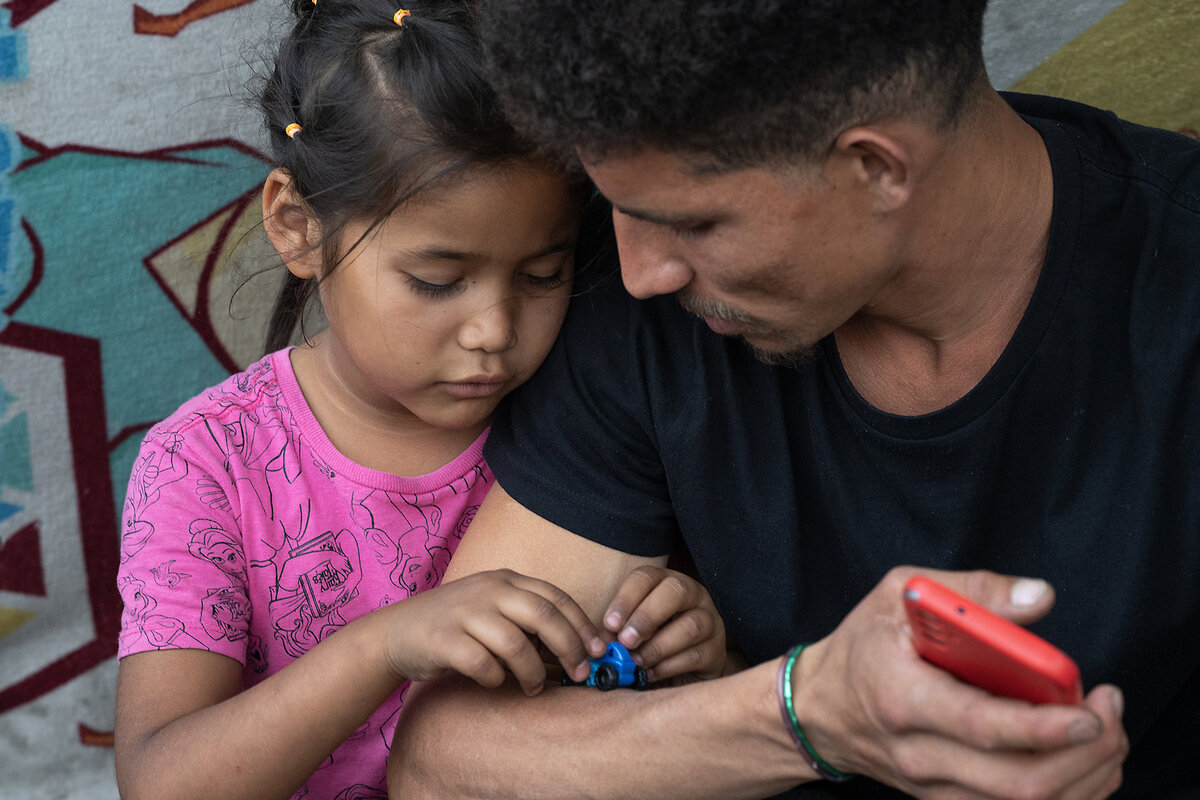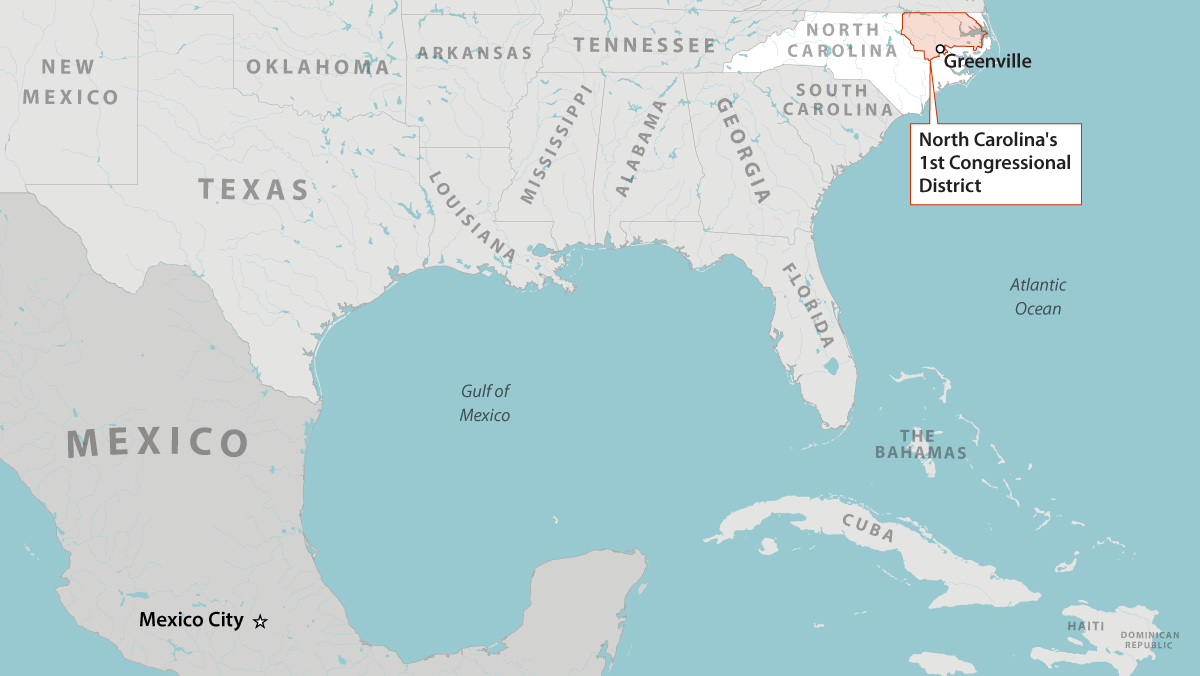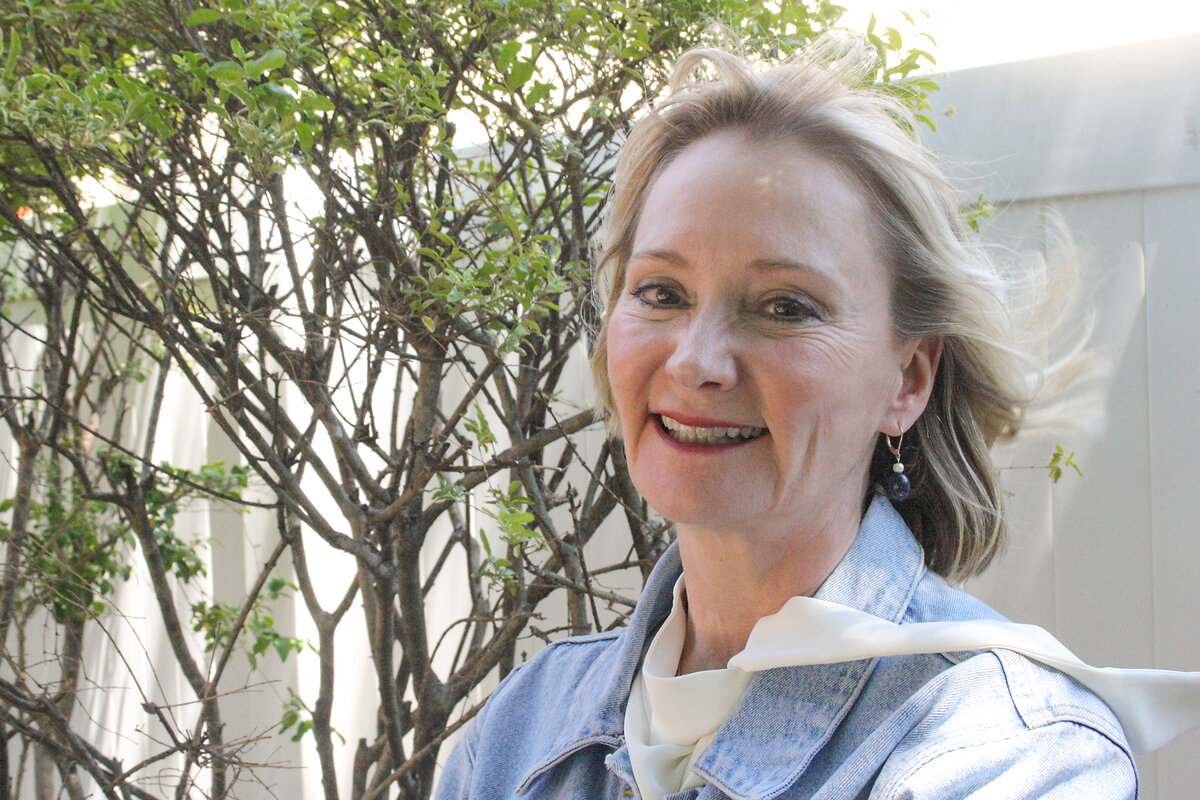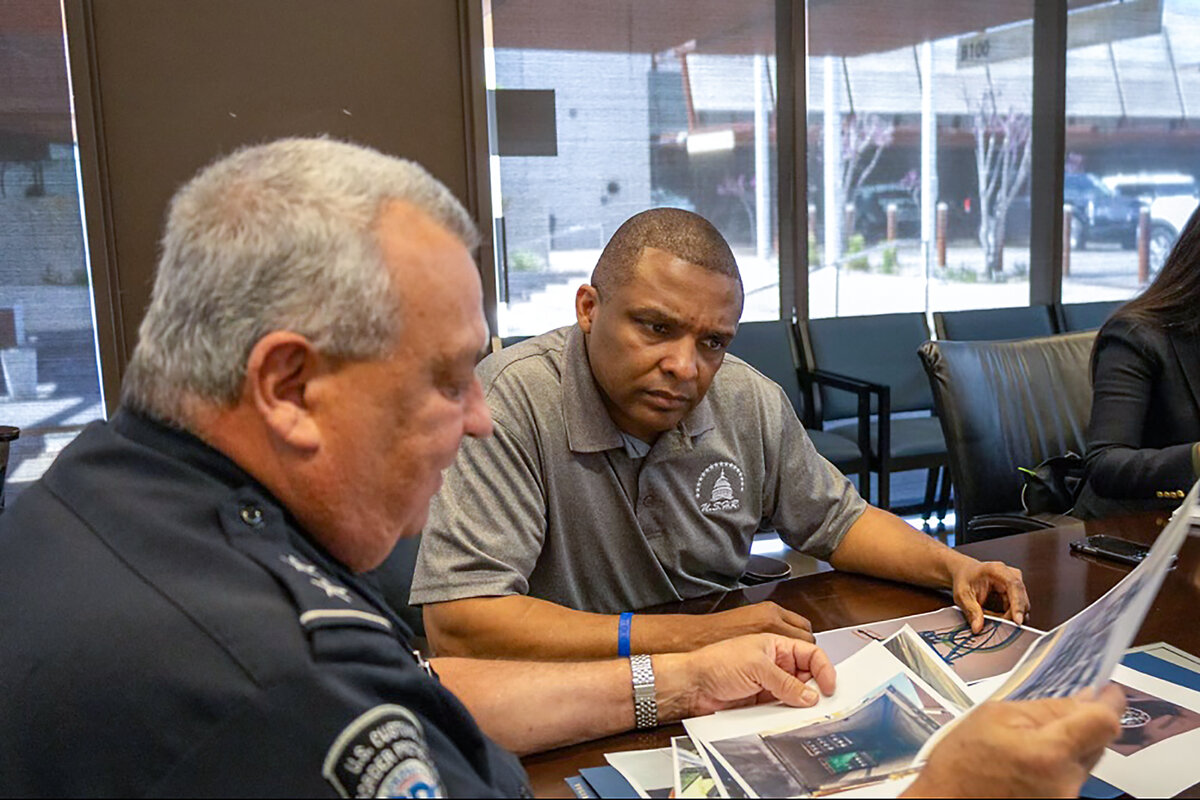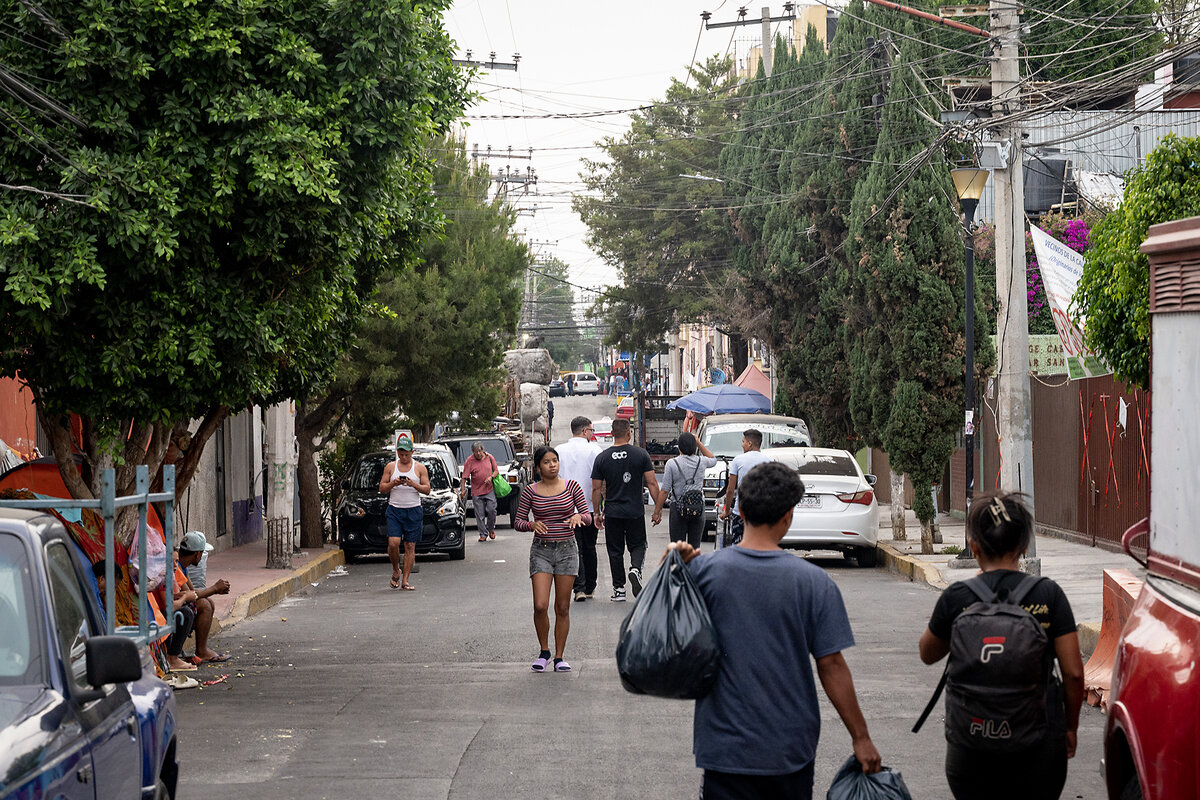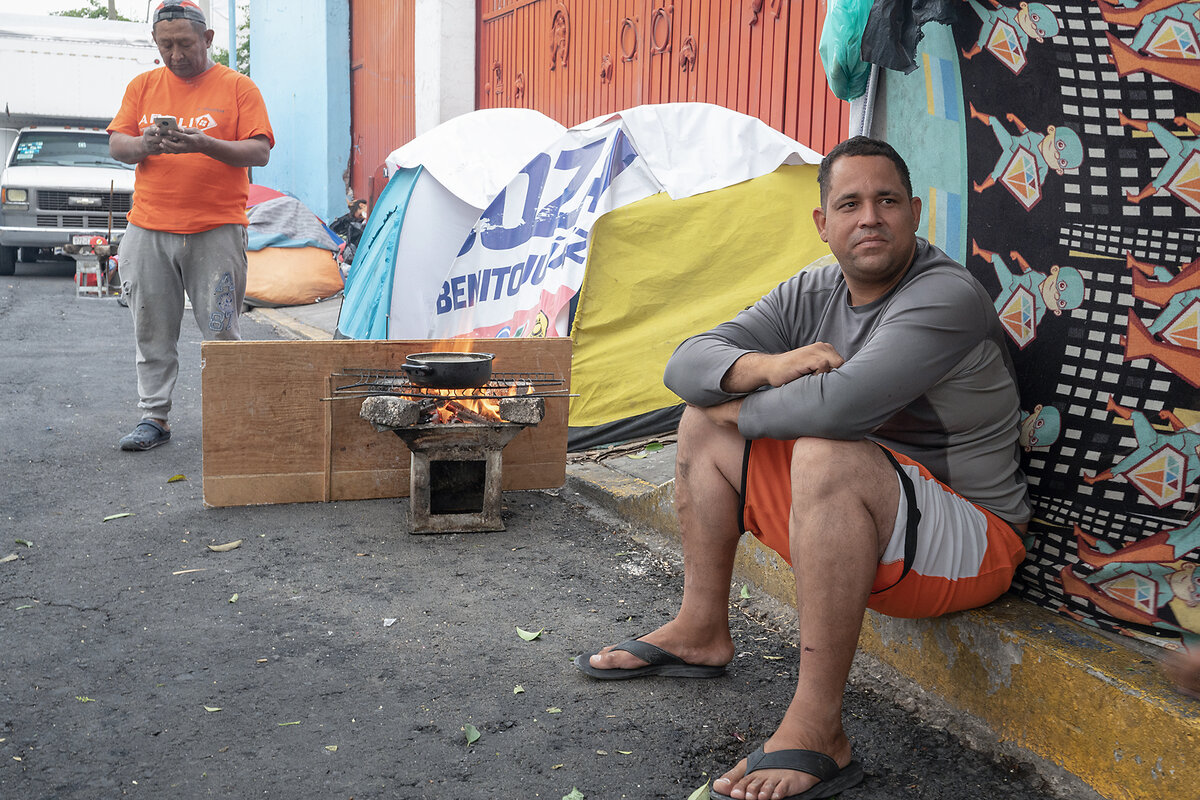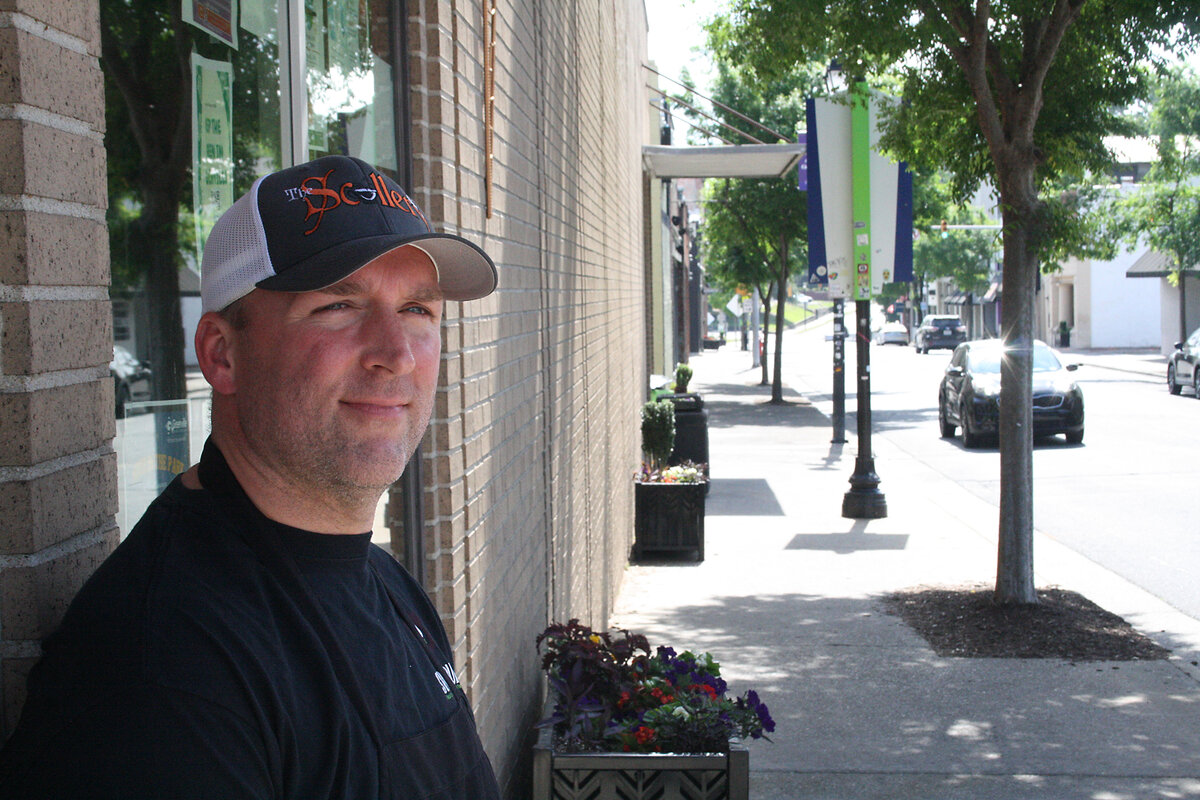Immigration is rising in the US and Mexico. Why it’s only an election issue in the US.
Loading...
| Mexico City; and Greenville, N.C.
There are no crowds of migrants huddled on the southern banks of the Tar River. Nor are there busloads of asylum-seekers emptying into the streets of downtown Greenville.
Geographically, eastern North Carolina is closer to Canada than it is to Mexico. And yet there, like in much of the United States, the southern border has felt closer than normal this year.
Presidential elections typically have pollsters keeping a close eye on economic indicators. This year, however, amid record numbers of migrant encounters at the U.S. southern border, combined with high-profile busing of asylum-seekers to major U.S. cities, immigration and border security have emerged as the most important issue for a majority of U.S. voters. And in eastern North Carolina – a purple region in a purple state – it’s front of mind for local candidates, regardless of political affiliation.
Why We Wrote This
The different ways in which immigration is influencing elections in the United States and in Mexico underscores each country’s distinct relationships with migrants and asylum-seekers.
The trend differs substantially south of the border. Mexico is also in an election year, voting for its next president and 20,000 local and national offices on June 2. Despite the growing numbers of asylum-seekers and migrants entering – and increasingly languishing – in Mexico in recent years, the topic of migration barely registers among Mexicans.
“It’s not a big issue – not for society, not for the government in general,” says Gerardo Maldonado, who researches public opinion toward foreigners in Mexico.
The contrast between how immigration is playing in the U.S. and Mexico elections points to each country’s unique history with migration and their expectations of migrant communities.
In the U.S., there are historical echoes to some of its most restrictive eras, as the immigration system encapsulates broader concerns around the economy, public safety, and cultural change.
“I don’t think it’s an exaggeration now to say every state is a border state,” says William Galston, a senior fellow at the Brookings Institution. Voters “want action.”
“The No. 1 issue”
Nestled in what is known as the Black Belt of the state, North Carolina’s 1st Congressional District has been a stronghold of moderate Democrats for over a century. It’s home to six of the ten poorest counties in the state. There are a few small cities and tens of thousands of acres of cotton, tobacco, soybeans, and other crops.
This year, the district will feature one of the most competitive elections in the state. Laurie Buckhout, a retired U.S. Army colonel and the Republican nominee, says there’s one topic she’s hearing about more than any other.
“Everywhere you go, the No. 1 issue is illegal immigration,” she says. “We have laws on the books, but they’re just not being followed.”
It’s something she and her Democratic opponent agree on. Since he took office in January last year, Rep. Don Davis has been a vocal supporter of reinforcing the border.
He has co-sponsored a bill allowing for the immediate deportation of migrants who attempt to enter the U.S. fraudulently, unless they fit certain humanitarian exceptions. Last month he was one of only five House Democrats to vote for a border security bill that would have revived Trump-era policies like Remain in Mexico and border wall construction.
He’s visited the border three times to look at how drugs and crime threaten his district, he says.
U.S. border agencies have reported an increase in the amount of fentanyl seized at the southern border, as well as in the number of detained migrants who are on the terrorist watch list. But the 169 people encountered by the U.S. Border Patrol last fiscal year on the watch list are a tiny fraction of the nearly 2.5 million foreigners encountered that year, and fentanyl is entering the country from all directions – including across the U.S. northern border and through the mail.
This district “may not be [seeing direct] foot traffic, but we’re seeing law enforcement have to engage” with border-related issues, says Representative Davis. “It’s up to all of us to fix the border crisis.”
Newcomers in Mexico
More than 1,500 miles south of Representative Davis’ district, in sprawling Mexico City, several new shelters have opened their doors to the growing population of migrants and asylum-seekers passing through and increasingly staying in Mexico over the past few years.
Mexico City is not a traditional stopping point along migrant routes to the U.S. But U.S. policies like the introduction of the CPB One application and pandemic-era border closures have required people hoping to enter the U.S. to use Mexico as a “waiting room,” according to Father Juan Luis Carbajal, who runs a new shelter in the working-class neighborhood of Iztapalapa.
Tarps and tents cover the sidewalks and edges of narrow residential streets for several blocks around the Casa del Migrante Arcángel Rafael in Iztapalapa, where Mr. Carbajal works. The shelter has been at or beyond capacity since it opened its doors in December 2023, and those who can’t find a space often choose to wait outside for weeks, their well-being officially the responsibility of the municipal government.
It’s been a shock for families and businesses near the shelter to suddenly see people from Venezuela, Haiti, Ecuador, and Nicaragua in the neighborhood looking for work, sleeping in alleyways, and trying to care for their families as they wait for beds to open or an asylum appointment to be confirmed. But despite some grumblings and glimmers of xenophobia, Mr. Carbajal feels the reception has been overwhelmingly positive: Locals regularly drop off food and clothing, or pass through to give free services, such as haircuts.
“I would be tired of people sleeping outside of my front door, too,” says Venezuelan José Antonio, who sits by a small tent with his 8-year-old daughter on a recent evening. They’ve been waiting over a month for open beds in the shelter. “It’s not a good situation for anyone.”
Despite the uptick in migrants arriving and spending more time in Mexico, Dr. Maldonado, the researcher, who chairs the international relations department at the Center for Research and Teaching in Economics, says positive attitudes toward foreigners have increased in Mexico since 2014, despite the larger presence of outsiders transiting or remaining in the country.
“Around 70% of the population will tell you that foreigners are a good thing, receiving new ideas and traditions from other countries is a good thing,” he says.
But when asked about specific groups, opinions shift. American, Spanish, Chinese, and Argentinian migrants tend to garner the most approval. There are some groups, such as Guatemalans, who have a long history of migrating to and through Mexico but are seen quite negatively, whether due to stereotypes about where they come from or their levels of education and skills they bring to Mexican society, Dr. Maldonado says.
Foreign-born people legally residing in Mexico make up just 1% of the total population as of 2020, the most recent census. This means that even if there’s a large-scale migrant caravan making its way across the country, or growing clusters of people biding their time in the capital, foreigners barely register within the broader population overall. There isn’t a strong correlation between attitudes toward foreigners and political ideology, experts say.
So it isn’t an easy topic for political parties to capitalize on like they do in the U.S., where it’s common to link economic challenges and crime to immigration.
“It’s really hard to create a political cost” around the presence of migrants in Mexico, says Gretchen Kuhner, director of the Mexico-based Institute for Women in Migration. “Migrants don’t vote, but they’re also in transit,” so the challenges they might bring to a specific community or state are viewed as temporary.
Earlier this spring, Amri Rafael Garido, a Venezuelan migrant sleeping outside the Archángel Rafael shelter, watches a compatriot cooking a pot of rice with noodles over a wood-fired stove. He laughs when asked about his plans: “We just want to get to the U.S.”
Reacting to changes
Back in the U.S., Representative Davis isn’t the only Democrat viewing immigration as a serious local issue. But there appears to be a new playbook for candidates in swing districts.
Earlier this year, Tom Suozzi won a special election in suburban New York pledging to be “tougher” on border issues than other Democrats are.
This contrasts with previous election cycles, when Democrats campaigned on the promise to reverse harsh, Trump-era immigration policies. But voter attitudes have shifted, and the move toward both parties focusing on the border isn’t surprising – given historical trends, experts say.
Around the turn of the 20th century, U.S. authorities processed an average of 5,000 migrants a day through Ellis Island. But that was also a time when the U.S. adopted some of its most restrictive immigration laws. Congress banned Chinese immigrants wholesale in the 1880s, and in 1921 it enacted the first ever quota on immigration, creating legal pathways that heavily favored northern Europeans.
By 1970, the foreign-born population in the U.S. had dropped to 4.7% from a record 14.8% in 1890. In 1989, with about 8% of the country foreign-born, then-President Ronald Reagan hailed immigration as “one of the most important sources of America’s greatness.”
But as of 2022, the immigrant population was again nearing 14%, and the reaction “is exactly the same as what we saw 100 years ago,” says David Bier, director of immigration studies at the Cato Institute. “We tend to have strong reactions when things change quickly.”
The irony in eastern North Carolina is that because it is an agricultural region, migrant workers are crucial to the economy.
The idea that “all politics is local” is increasingly untrue, says Peter Francia, a political scientist at East Carolina University in Greenville, in an email.
“The election issues likely to dominate in eastern North Carolina probably will not look much different from the election issues” dominating in other parts of the country, he says. Border security concerns aren’t “going away.”
What matters most to Mexican voters
Mexico has a long tradition of opening its doors to refugees, too. It welcomed populations fleeing the Spanish Civil War, World War II, and brutal dictatorships in Chile, Argentina, and Uruguay. And most Mexican families, regardless of economic class, know someone who has lived or worked in the U.S. at some point, creating a level of cultural understanding around what motivates someone to leave home and seek safety or opportunity elsewhere.
Mexico’s political narrative plays off this, with all three presidential candidates in the debates this spring talking about addressing root causes of migration in other countries as a solution to the influx of human migration in the region.
The political rhetoric of open doors and treating migrants with dignity doesn’t align with policy actions inside Mexico, however, says Alexandra Délano, associate professor of global studies at The New School in New York.
For more than a decade, analysts have described the U.S. border as moving south to the Mexico-Guatemala border – because of the ongoing pressure the U.S. has exerted on Mexico to stop migrants before they get to the U.S. That’s happening through the militarization of immigration control in Mexico, and through policies that bus migrants south, deter them at checkpoints, and place them in immigration detention centers, like the one that went up in flames with scores of migrants locked inside last year.
Regardless of who wins the presidency this weekend, Dr. Délano expects the next leader to agree to carry out whatever immigration policy the U.S. demands of them. It’s part of the power imbalance, where Mexico’s economy and security rely heavily on U.S. investment and cooperation.
Those also happen to be the topics that matter most to Mexican voters.
“There’s over 100,000 missing people in Mexico. The list of human rights violations is so long and so atrocious, it’s difficult to get your tragedy on the radar of politicians,” says Ms. Kuhner. Migration “is an issue that no [politician] wants to touch because the pressure from the U.S. is not going to change.”
Immigration and the economy
Even in North Carolina, some question just how key border security is to voters in the big picture. According to a February poll conducted by Dr. Francia, the top issue in the state is inflation.
“I can’t say I don’t care about” immigration, says David Lawson, a Greenville local, on a recent morning, but it “doesn’t really affect me.”
“Jobs, pay raises, the economy ... inflation,” he says, “who’s going to help with that?”
Across the street, Matthew Scully is working through the morning rush at his restaurant, The Scullery. The coffee house achieved viral fame in 2019 when, on the day of a rally for Donald Trump, it donated the day’s proceeds to an immigrant aid group.
Immigration is “very important to me ... but I wouldn’t put it as No. 1,” says Mr. Scully.
“As an American, you have to have some sort of empathy for [migrants],” he says. “You also have to have security and safety.”
Editor's note: This story has been corrected to fix the spelling of Amri Rafael Garido's surname.





